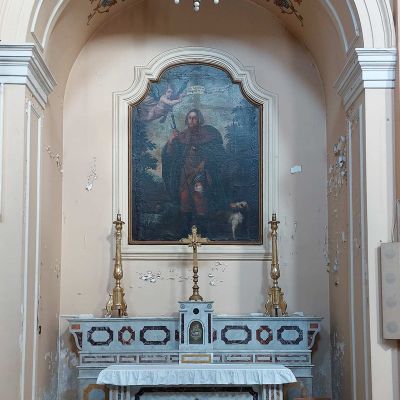Church of the Virgin Mary
According to the testimony of the historian Francescano Serafino Profilo in his manuscript of 1760, the Franciscan friars arrived in Mesagne in 1425. It was the Mesagnese nobleman Aymonetto Sangiorgio and his wife Maria rima de Maya who asked Pope Martino V for permission to build the church and the monastery; permission that was given on the 4th of August 1425. The church, named after Santa Maria di Nazareth (Saint Mary of Nazareth), was therefore built along with the monastery for the Franciscan friars. The monastery’s church, situated just outside the city walls, was for many years, frequented by artisans and citizens.
We have a splendid description of the church by the historian Cataldo Antonio Mannarino from 1596. According to him the worship of the Immaculate Conception took root in the church and in the XVII century a confraternity of the same name took up residence there.
In addition to the Sangiorgio family, other noble families became benefactors of the Franciscans, such as the Cantoni and Musacchi families.
The monastery of the Franciscans has witnessed various phases of construction; some documents state that in 1720 new work commenced and that in 1731, according to the Regio Tavolario (royal engineer or architect) Pietro Vinaccia in his Apprezzo del Feudo di Mesagne (Appraisal of the Estate of Mesagne), the work was still not completed. Unfortunately, the earthquake on the 20th of February 1743 damaged both the monastery and the church, and so in the October of the same year the friars gave the mandate for the reconstruction to the master builders Basilio and Valentino de Virgiliis di Oria. In 1755, the work on the monastery was finished and attention turned to the rebuilding of the church that was constructed following the design by the master engineer and plasterer Domenico Basile, who was probably from Martina Franca./p>
From 1775 to 1760 the chapels were also built. We know that in 1757 the baron Giuseppe Geofilo endowed and contributed to the decoration of a chapel dedicated to Saint Diego, and that in 1760, the baron Nicola Scelba and his father Giovanni decorated their new chapel dedicated to Saint Antonio of Padova.
After the suppression of the Franciscan order that occurred in 1809, the monastery was assigned as the headquarters of the Royal Gendarmerie and as a jail. After 1860 it experienced a period of abandonment and then it was sold to private citizens. Since 1922, the first floor has been equipped as a hotel.
The church, oriented to the west, has an impressive and sober structure; externally it is virtually devoid of any decoration. Attached to the church is the bell tower with three rib vaults which is also very simple, with three bells, made with ashlars in carparo stone recovered from the old defensive walls of Mesagne by Maestro Ludovico Verardi in 1652.
Internally, there is a single nave and eight chapels. The first, on the left, has a wooden crucifix from the XVIII century; the second, on the right, has a canvas painting from the 1700s of Saint Diego d’Alcalà (belonging to the Geofilo family); the second on the left has a 18th century painting of Saint Rocco; the third chapel on the right houses a canvas of the rapture of Saint Francis of Assisi, painted in 1753 by Antonio Domenico Carella. Again by Antonio Domenico Carella is the canvas painting of 1759 with Saint Anthony of Padova in the fourth chapel on the left. The fifth chapel on the right is dedicated to Saint Francis of Paola and the 19th century picture was painted by the Roman painter L.C. Camerini. The sixth chapel on the left is named after the Vergine Immacolata and houses a 19th century canvas by Antonio Criscuolo of Mesagne. The painting depicts the triumph of the Virgin Mary amongst a chorus of angels that support Marian symbols.
Finally, it is worth highlighting the four 18th century canvases by the sides of the altar that depict scenes of the last hours of Christ’s life.










